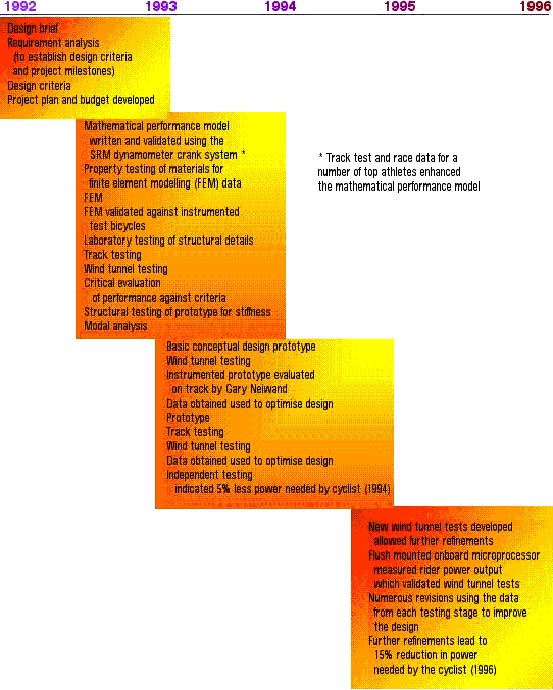|
An accidental beginning
The Superbike project started by accident in 1992, before
the Barcelona Olympics. Lachlan Thompson, who specialises
in aerodynamics, was setting up a photo session to contrast
the cutting edge technology of a jet fighter with the antique
technology of a bicycle. However, the cycling model failed
to arrive. So Thompson went into Swanston Street, Melbourne
and spotted a young woman cyclist. The cyclist was Kathy Watt,
an Australian champion. In return for doing the photoshoot,
Thompson offered to put Watt in the RMIT wind tunnel to check
the aerodynamics of her bike and riding position.
When
biomechanist Dr Brian McLean of the AIS heard about this,
he wanted all the other AIS cyclists checked in preparation
for Barcelona. During the wind tunnel testing Thompson revealed
he had already done some preliminary work on bicycle design
which had been shelved. One thing led to another; a project
team was formed and the Superbike was developed in consultation
with Olympic cycling team coach Charlie Walsh.
UCI
rules
At the time the rules of the Union Cycliste Internationale
(UCI) stipulated that a bicycle must have three tubes in the
frame. For this reason an aerodynamic monocoque (one-piece
construction) was not considered by the project team. However,
after the project began, the UCI changed its technical ruling
to less restrictive specifications, so that bikes could differ
from the standard three-tubed triangular configuration.
Design
criteria
In the demanding, practical world of international cycling,
if the new bike was to be successful it had to achieve the
performance goals of:
- optimising
weight
- frame
stiffness
- aerodynamics
without
compromising the simplicity, versatility and reliability of
a standard bike.
Australian
Olympic track cycling coach Charlie Walsh defined the
initial design criteria with the project team in late
1992. The new bicycle must use a conventional group set
of standard cranks, bearings, brakes, wheels, forks, handlebars,
seat etc. The resulting design must equal or exceed the
structural stiffness of a steel bicycle while offering
lower aerodynamic drag and weight without compromising
reliability. The resulting design should also be suitable
for low-cost high volume production. (Thompson, 1996:
4)
Project
team
The project team included scientists, engineers, technicians
and students from RMIT and the AIS. Much of the hard work
was done by engineering students, who worked tirelessly during
the critical stages of the bike's development. A computer-aided
drawing software program called Cadkey,
which uses a 3D database, was used to model the bike while
another program, STRAND6,
was used for finite element modelling (FEM), a technique used
by engineers to predict the behaviour of structures under
different loads (forces).
Activity
| 1. |
Identify a feature of the Superbike that will meet the
performance goals (criteria) above. For example, placement
of the rider would enhance aerodynamics. |
| 2. |
Based on your current knowledge of bike technology, identify
criteria from the quote above which required application
of new and emerging technologies and innovative design. |
Milestones
in design development

The
continued successful development of the 'Superbike' is
not due to any one factor being superior. Instead the
credit goes to the application of a validated
mathematical performance model that can rapidly evaluate
structural, aerodynamic requirements and riding position.
(Thompson, 1996: 5)
Activity
| 1. |
Take
a careful look at the Milestones in design development;
in particular, note the changes in power required by a
cyclist to move the bicycle. Note that it took two years
of development to further enhance the power reduction
to 15%. Estimate from the milestones how many prototypes
were needed to achieve this marked improvement. |
| 2. |
Explain
the difference between static and dynamic testing. |
| 3. |
What
is the role of a prototype? |
| 4. |
From
the Milestones in design development, identify
those instances where evaluations were conducted. |
|
![]()
![]()
![]()